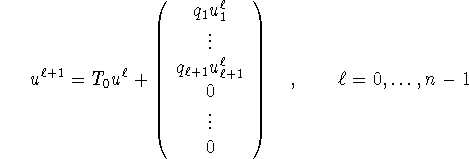Now let ![]() with
with ![]() known and Q a diagonal matrix whose
entries we denote by
known and Q a diagonal matrix whose
entries we denote by ![]() . Let
. Let ![]() be a solution to
be a solution to
with ![]() the first unit vector. We consider the inverse problem of
recovering Q from
the first unit vector. We consider the inverse problem of
recovering Q from
![]()
Again we make use of the transmutation L from Theorem 2.1. Multiplying (4.1) with E L we obtain from (2.1)
![]()
Thus the vectors ![]() satisfy
satisfy
i.e. ![]() in components
in components ![]() .
Since
.
Since ![]() is tridiagonal we can show that for
is tridiagonal we can show that for
![]()
We use induction with respect to k. The case k = 0 is obvious.
Assume that (4.3) is correct for some k with
![]() . From (4.2) we get
. From (4.2) we get
![]()
For the evaluation of ![]() , we
need only the first n-k components of
, we
need only the first n-k components of ![]() since
since ![]() is
tridiagonal. Thus, by the induction hypothesis,
is
tridiagonal. Thus, by the induction hypothesis,
![]()
This is (4.3) for k+1. Hence (4.3) is established.
Since the first row of L is ![]() we also have
we also have
![]()
This combines with (4.3) to yield, for ![]() ,
,
![]()
Introducing the row vector
![]()
we have
and
With the (n,n)-matrices

(4.4) simply reads
![]()
Note that ![]() is upper triangular with diagonal elements
is upper triangular with diagonal elements

Thus ![]() is invertible provided that
is invertible provided that ![]() ,
,
![]() .
Hence
.
Hence
![]()
which determines Z by the data.
The relations ![]() can be written as
can be written as
![]()
We finally obtain
![]()
Since T is tridiagonal and ![]() , U is upper triangular, its
diagonal entries being
, U is upper triangular, its
diagonal entries being

Thus L, U can be determined simply by doing an L U-decomposition
on the matrix ![]() , with the diagonal of U being known.
, with the diagonal of U being known.
Once L, U are known there is a variety of ways to find Q. For instance
we can compute ![]() from
from ![]() and
and

which is (4.4) for ![]() .
Then,
.
Then,

from which ![]() can be computed recursively since
can be computed recursively since
![]() ,
, ![]() . This solves the
inverse evolution problem.
. This solves the
inverse evolution problem.